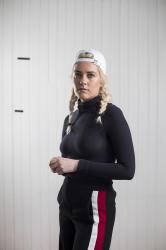
As a flicker of light appears at the end of the pandemic tunnel, we sat down with the next generation of Icelandic artists to discuss the future. The conversations were freeform—some focused on the upcoming years, others reflected on realisations from the past months, others still looked with wide-eyes at the future of the scene, which has only grown within the restrictions of the coronavirus.
Presenting, an artistic vision of the future, as told by the future. Today, we talk to Sigurður Ámundason.

Sigurður Ámundason. Photo by Art Bicnick
Sigurður Ámundason
Over the course of the pandemic, Sigurður Ámundason read Miguel de Cervantes’ ‘Don Quixote’. “It’s just this huge gigantic masterpiece,” he raves. “But according to the prologue, Cervantes was so excited to write it that he made a few errors. There’s a scene with Sancho Panza where he has a donkey, then someone steals it, but then later he’s on it again.” Sigurður smiles brightly—as if he himself has just seen a windmill in the distance. “I love the idea of a masterpiece being flawed. It doesn’t have to be completely perfect to be the first modern novel ever written, as it’s called.”

Artwork by Sigurður Ámundason.
Waving to the wrong person
Sigurður’s work, he explains, explores the monotonous struggles of mankind. “Bad communication with people, awkwardness, misunderstandings,” he lists. “You know, you forget to say hello to someone because you didn’t realise it was them. That’s a small nightmare and that’s what I’m interested in, so I try to blow them up using heavy imagery to represent the cringey moments of everyday life.”
Through the many ups and downs of the pandemic, Sigurður found immense meaning in the worldwide #BlackLivesMatter protests in May and June. At the time, he was working at the National History Museum.
“There were no tours or guests and we were surrounded by this ancient art. Everything was going on in the world but everything was dead here. We were just stuck on this island,” he relays.
For Sigurður, the protests spurred on a moment of reflection and empathy.
“It felt like there was nothing you could really do because I didn’t know that experience. As a white man, I don’t know what that is, but I wanted to,” he explains. “I’ve never experienced the horrors of war or racism but maybe we can relate on some small things. Maybe you have some awkward communication with someone at the protest and just feel horrible or angry or frustrated because of that and then you’re miserable. That’s something we can all share. That’s the commonality and that’s what I want to explore with my art: the mundane horrors that we all have.”

Artwork by Sigurður Ámundason.
Finding commonality
Sigurður sees concentrating on these small horrors—and the shared humanity of it all—as the key for those from more privileged groups, who don’t have the same experiences as those within marginalised groups, to connect with each other.
“If you see someone that looks like you hurting someone that doesn’t look like you, it’s easier for people to see [the situation] from the perspective of the [person] they look like,” he continues. “But instead of that, try to understand and relate to the struggle of the person that’s being harassed. People really need to shift their minds to relate to the pain in others.”

Artwork by Sigurður Ámundason.
Check out Sigurður Ámundason on Instagram.
Note: Due to the effect the Coronavirus is having on tourism in Iceland, it’s become increasingly difficult for the Grapevine to survive. If you enjoy our content and want to help the Grapevine’s journalists do things like eat and pay rent, please consider joining our High Five Club.
You can also check out our shop, loaded with books, apparel and other cool merch, that you can buy and have delivered right to your door.
Buy subscriptions, t-shirts and more from our shop right here!















